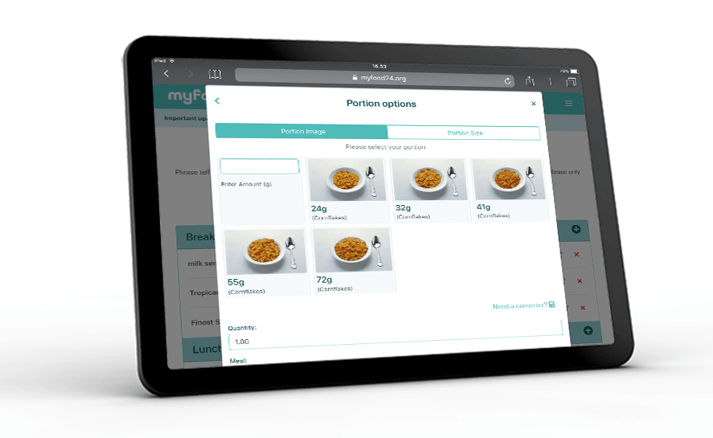With the growing need to accurately collect and analyse nutrient and dietary data, innovative technologies become a staple solution to solve the common dilemmas with intake assessments – cue myfood24.
We use our own crafted online food diary system and many in-depth databases to automatically calculate the nutritional compositions of generic and branded food items for over 100 different nutrients, vitamins and minerals.
But, what makes myfood24 so great?
Our take on dietary assessment
For many of us, it’s easy to say that we don’t know the nutritional composition of everything we eat, despite packaging labels telling us it’s part of our five a day or that a product is low in fat or sugar. It’s known that a healthy and balanced diet is critical for good health, but the issue in monitoring this lies with the varying day-to-day diet.
It’s a massive obstacle for researchers and healthcare professionals to gather accurate intake data for dietary and nutritional assessments and sourcing those crucial factors potentially causing diet-related disease.
As a solution, myfood24 was specifically designed by a team of nutritionists and experts with evidence-based methodologies with speed, accuracy, and efficiency in mind.
Our system uses two key technologies to do this.
Our food diary
The foundation that makes myfood24 distinctive is how the online food diary works to generate bespoke nutritional analysis.
How it works
For starters, all of the hard work has been done for you, without anyone needing to lift a finger – well, other than to click ‘submit diary’.
Users self-complete an online diary to log their food and drink consumption, using the search tool to find the items they’ve eaten.
A clicked food item will display portion options, allowing a user to enter their portion size manually or with some foods, select a helpful portion size image to help them choose a more accurate representation of their food intake.
Our diary prompts a user to include accompaniments and commonly forgotten items too, such as tea with milk and sugar or toast with butter and jam, saving time endlessly searching for each item.
But what if someone cooks homemade meals? To that, we say no problem.
Users can use our meal and recipe builder to create commonly eaten foods, automatically taking into account the weight and nutrient changes on cooking.
After a diary has been submitted, myfood24 analyses the dietary and nutritional intake instantly.
It generates detailed outputs, including spreadsheets, graphs, charts and a break down of each food’s nutrient composition, item by item.
Rather than conducting timely interviews or manually inputting nutritional information of every food using other FCDs, you can say goodbye to the long and tedious task of collecting data.
Our database
The diary operates using our database, so when a user searches for a food or drink item, it will contain every piece of information myfood24 has on that product – from the name, brand, its macro- and micronutrients and much more.
 How it works
How it works
Stemming from its original framework of McCance and Widdowson’s composition of foods1, myfood24 has developed several unique and comprehensive datasets to expand the number of food and drink items to over 92,000* – including branded items you can whip off the supermarket shelves or buy from commercial food chains.
Every item we log is meticulously mapped using a specific mapping exercise to match the branded level macronutrient data to the micronutrient food composition data for a more complete and representative database. This advanced tool has allowed our software to solve the typical issues found within food composition databases.
The problem with regular FCDs
Even though food composition databases are most commonly used for dietary assessment and useful to determine a food’s nutritional composition, there can be extensive issues with their accuracy.
To put this into context, if we take four food items like white bread originating from different sources or locations, those four products will be collected together as one sample and analysed chemically to determine a nutritional composition average.
These pooled estimates risk no brand-level variance, and many products will be missing or have incomplete nutritional information.
On top of all this, FCDs cannot always be entirely up to date due to constant food developments and product rollouts.
How myfood24 solves FCD issues
This is where our powerful mapping exercise comes in to cover all of these drawbacks.
Using this tool to map every single item, our database contains accurate nutritional compositions of all generic and branded level foods, down to the very last micronutrient.
Our datasets are always expanding and improved by our data specialists to keep everything detailed and up to date, reflecting the wide range of food and drink products available without the need to crowdsource.
*The number of food and drink items represented in the UK database.
Our software has been individually specialised for research, education, and healthcare uses.
So, now you know the features of myfood24, why not take advantage of our free demo to find out how we could work for you?
 How it works
How it works